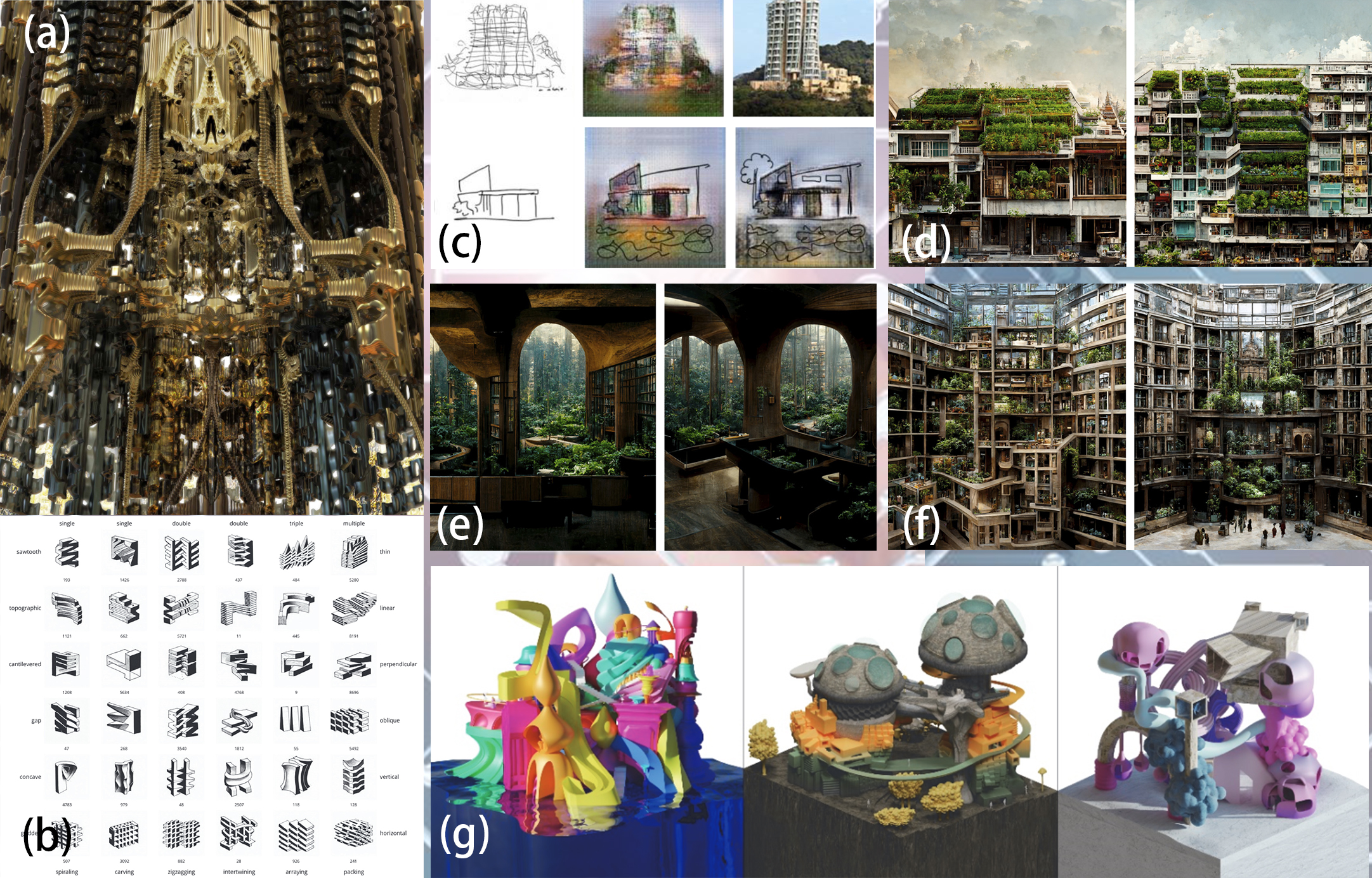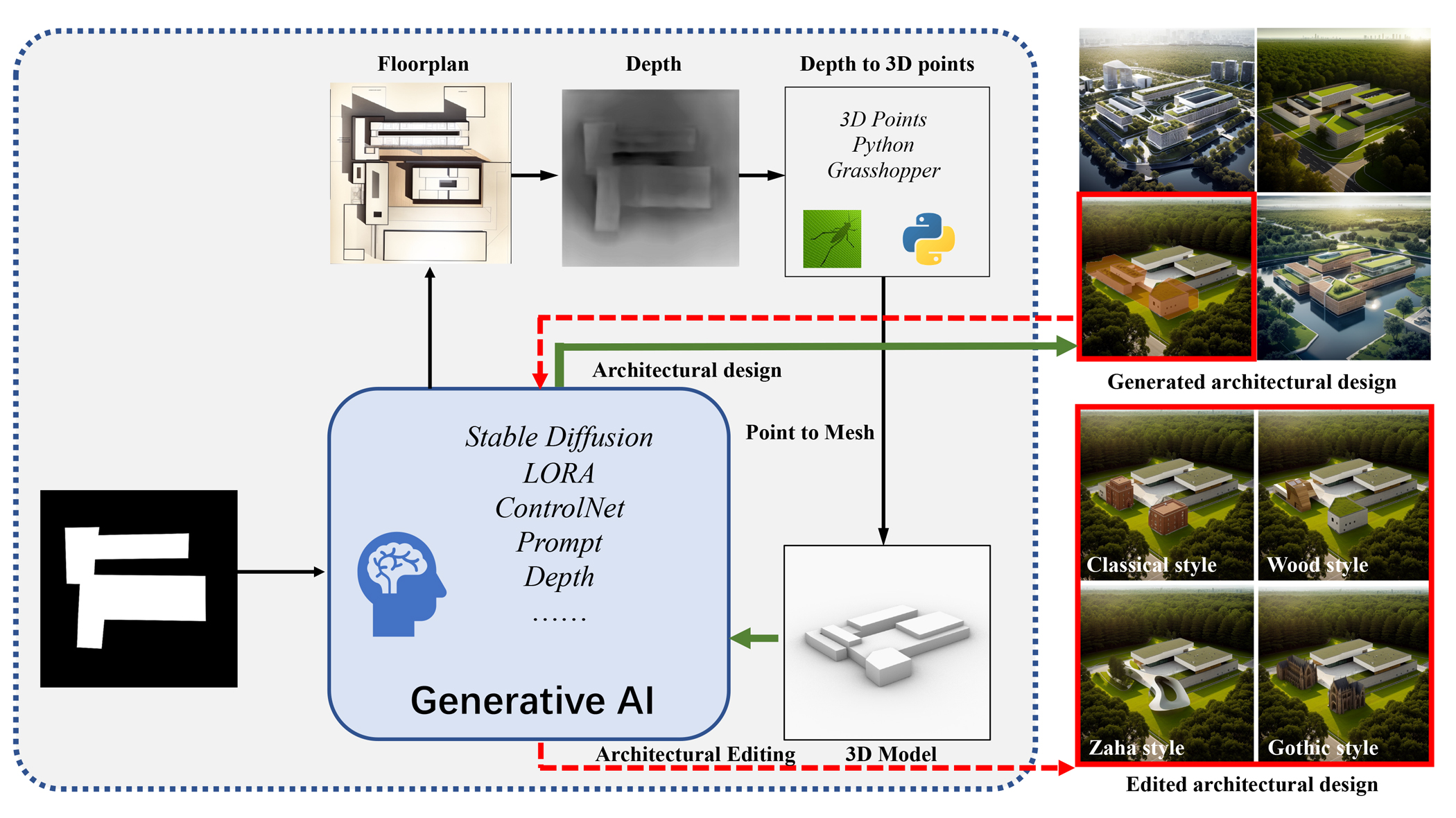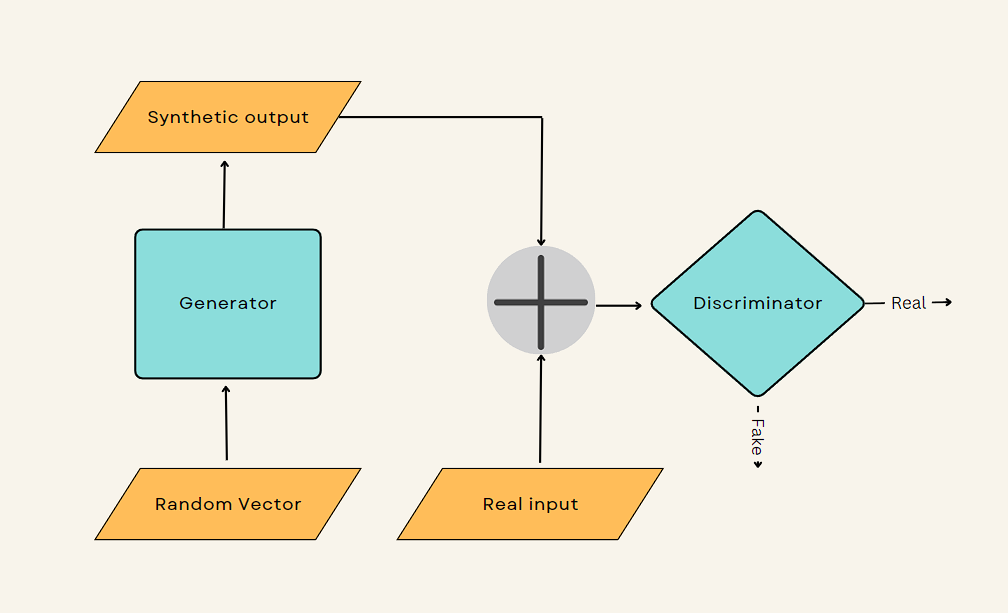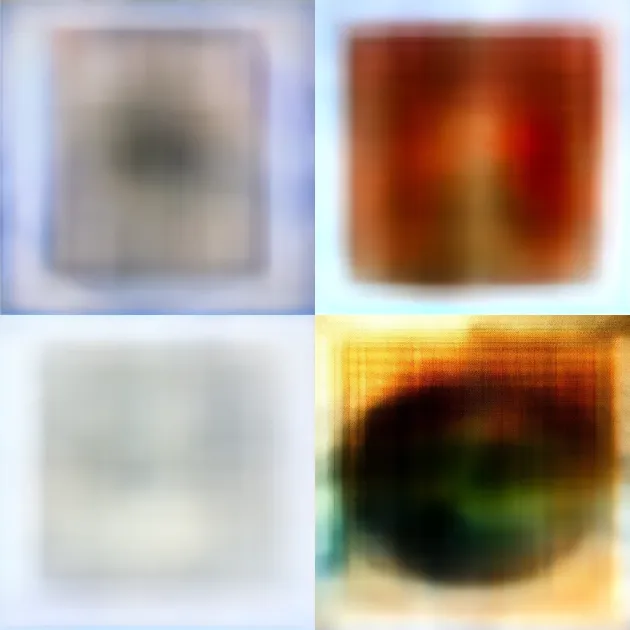Generative AI for Architectural Design: A Literature Review
2404.01335

0
0

Abstract
Generative Artificial Intelligence (AI) has pioneered new methodological paradigms in architectural design, significantly expanding the innovative potential and efficiency of the design process. This paper explores the extensive applications of generative AI technologies in architectural design, a trend that has benefited from the rapid development of deep generative models. This article provides a comprehensive review of the basic principles of generative AI and large-scale models and highlights the applications in the generation of 2D images, videos, and 3D models. In addition, by reviewing the latest literature from 2020, this paper scrutinizes the impact of generative AI technologies at different stages of architectural design, from generating initial architectural 3D forms to producing final architectural imagery. The marked trend of research growth indicates an increasing inclination within the architectural design community towards embracing generative AI, thereby catalyzing a shared enthusiasm for research. These research cases and methodologies have not only proven to enhance efficiency and innovation significantly but have also posed challenges to the conventional boundaries of architectural creativity. Finally, we point out new directions for design innovation and articulate fresh trajectories for applying generative AI in the architectural domain. This article provides the first comprehensive literature review about generative AI for architectural design, and we believe this work can facilitate more research work on this significant topic in architecture.
Create account to get full access
Overview
- This paper provides a literature review on the use of generative AI for architectural design.
- The authors discuss the motivations behind applying AI to architectural design, as well as the structure and methodology of their review.
- Key topics covered include the current state of generative AI techniques, their applications in architectural design, and the challenges and opportunities in this emerging field.
Plain English Explanation
The paper examines how artificial intelligence (AI) technologies are being used to help design buildings and other architectural structures. Architects and designers are increasingly turning to AI-powered generative tools that can automatically create new design concepts and variations.
The researchers wanted to understand the current landscape of this technology and its potential impacts on the field of architecture. They reviewed a wide range of existing research papers to identify the key ways AI is being applied, the benefits it can provide, and the obstacles that still need to be addressed.
Some of the main uses of generative AI in architecture include generating initial design ideas, exploring alternative layouts and floor plans, optimizing building performance, and automating repetitive tasks. By tapping into the creative and analytical capabilities of AI, architects can potentially save time, reduce costs, and generate more innovative designs.
However, there are also concerns about AI potentially replacing human creativity, the difficulty of interpreting AI-generated designs, and the need for greater collaboration between designers and AI systems. The researchers highlight these challenges and discuss ways the technology might continue to evolve to better support the architectural design process.
Technical Explanation
The paper presents a systematic literature review on the use of generative AI techniques in architectural design. The authors categorize the existing research into several key themes:
-
Generative Design Approaches: This covers the different AI algorithms and models being applied, such as generative adversarial networks (GANs), variational autoencoders (VAEs), and reinforcement learning. The review examines how these techniques can generate new architectural forms, floor plans, and design alternatives.
-
Applications in Architectural Design: The researchers identify a range of use cases where generative AI is being leveraged, including conceptual design ideation, building performance optimization, and automating repetitive tasks like facade modeling.
-
Challenges and Limitations: The review delves into the technical, practical, and ethical obstacles that arise when integrating generative AI into the architectural workflow. Issues like interpretability, human-AI collaboration, and bias in training data are discussed.
-
Future Directions: Building on the insights from the literature, the authors outline potential avenues for advancing generative AI capabilities and better aligning them with the needs of architectural design professionals.
The paper provides a comprehensive overview of the state-of-the-art in this emerging field, synthesizing findings from a diverse set of academic publications. It offers a useful foundation for researchers and practitioners seeking to understand the current applications and limitations of generative AI in the context of architectural design.
Critical Analysis
The literature review presents a thorough and balanced assessment of the current state of generative AI in architectural design. The authors do a commendable job of covering a wide range of relevant research while maintaining a clear structure and coherent narrative.
One strength of the paper is its detailed exploration of the technical approaches underpinning generative AI, which provides helpful context for understanding the capabilities and limitations of these tools. The discussion of use cases also offers a realistic perspective on where the technology is currently being applied and the benefits it can deliver.
However, the review could have delved deeper into some of the ethical and social implications of AI-powered architectural design. For example, the paper briefly mentions concerns about bias and lack of interpretability, but does not explore these issues in great depth. Similarly, the potential impacts on the architectural profession and design education could have been analyzed more extensively.
Additionally, while the authors outline future research directions, they could have provided a more critical assessment of the technical roadblocks and conceptual challenges that need to be overcome. A more nuanced discussion of the limitations and tradeoffs inherent in current generative AI approaches would have strengthened the analysis.
Overall, this paper serves as a valuable reference for understanding the current landscape of generative AI in architectural design. Its comprehensive coverage and balanced perspective make it a solid starting point for further exploration of this rapidly evolving field.
Conclusion
This literature review offers a detailed examination of how generative AI is being applied in the context of architectural design. The researchers have done an impressive job of synthesizing a wide range of existing research to provide a holistic understanding of the current state of the technology, its benefits, and the challenges that need to be addressed.
While the paper could have delved deeper into some of the ethical and social implications, it nonetheless offers a solid foundation for architects, researchers, and others interested in exploring the potential of AI-powered design tools. As the field continues to evolve, this review provides a useful baseline for understanding the current landscape and contemplating the future directions of this promising area of innovation.
This summary was produced with help from an AI and may contain inaccuracies - check out the links to read the original source documents!
Related Papers

Sketch-to-Architecture: Generative AI-aided Architectural Design
Pengzhi Li, Baijuan Li, Zhiheng Li

0
0
Recently, the development of large-scale models has paved the way for various interdisciplinary research, including architecture. By using generative AI, we present a novel workflow that utilizes AI models to generate conceptual floorplans and 3D models from simple sketches, enabling rapid ideation and controlled generation of architectural renderings based on textual descriptions. Our work demonstrates the potential of generative AI in the architectural design process, pointing towards a new direction of computer-aided architectural design. Our project website is available at: https://zrealli.github.io/sketch2arc
4/1/2024

Generative Artificial Intelligence: A Systematic Review and Applications
Sandeep Singh Sengar, Affan Bin Hasan, Sanjay Kumar, Fiona Carroll

0
0
In recent years, the study of artificial intelligence (AI) has undergone a paradigm shift. This has been propelled by the groundbreaking capabilities of generative models both in supervised and unsupervised learning scenarios. Generative AI has shown state-of-the-art performance in solving perplexing real-world conundrums in fields such as image translation, medical diagnostics, textual imagery fusion, natural language processing, and beyond. This paper documents the systematic review and analysis of recent advancements and techniques in Generative AI with a detailed discussion of their applications including application-specific models. Indeed, the major impact that generative AI has made to date, has been in language generation with the development of large language models, in the field of image translation and several other interdisciplinary applications of generative AI. Moreover, the primary contribution of this paper lies in its coherent synthesis of the latest advancements in these areas, seamlessly weaving together contemporary breakthroughs in the field. Particularly, how it shares an exploration of the future trajectory for generative AI. In conclusion, the paper ends with a discussion of Responsible AI principles, and the necessary ethical considerations for the sustainability and growth of these generative models.
5/21/2024
🤿
Towards AI-Architecture Liberty: A Comprehensive Survey on Designing and Collaborating Virtual Architecture by Deep Learning in the Metaverse
Anqi Wang, Jiahua Dong, Lik-Hang Lee, Jiachuan Shen, Pan Hui

0
0
3D shape generation techniques leveraging deep learning have garnered significant interest from both the computer vision and architectural design communities, promising to enrich the content of the future metaverse. However, research on virtual architectural design remains limited, particularly regarding human-AI collaboration and deep learning-assisted design. We first illuminate the principles, generation techniques, and current literature of virtual architecture, focusing on challenges such as datasets, multimodality, design intuition, and generative frameworks. In our survey, we reviewed 187 related articles (80.7% of articles published between 2018 and 2022) covering architectural research, virtual environments, and technical approaches. This survey investigates the latest approaches to 3D object generation with deep generative models (DGMs) and summarizes four characteristics of deep-learning generation approaches for virtual architecture. According to our analysis of the survey, we expound on four research agendas, including agency, communication, user consideration, and integrating tools, and highlight three important enablers of ubiquitous interaction with immersive systems in deep learning-assisted architectural generation. Our work contributes to fostering understanding between designers and deep learning techniques, broadening access to human-AI collaboration. We advocate for interdisciplinary efforts to address this timely research topic, facilitating content designing and generation in the metaverse.
4/9/2024

Automating Computational Design with Generative AI
Joern Ploennigs, Markus Berger

0
0
AI image generators based on diffusion models have recently garnered attention for their capability to create images from simple text prompts. However, for practical use in civil engineering they need to be able to create specific construction plans for given constraints. This paper investigates the potential of current AI generators in addressing such challenges, specifically for the creation of simple floor plans. We explain how the underlying diffusion-models work and propose novel refinement approaches to improve semantic encoding and generation quality. In several experiments we show that we can improve validity of generated floor plans from 6% to 90%. Based on these results we derive future research challenges considering building information modelling. With this we provide: (i) evaluation of current generative AIs; (ii) propose improved refinement approaches; (iii) evaluate them on various examples; (iv) derive future directions for diffusion models in civil engineering.
5/6/2024